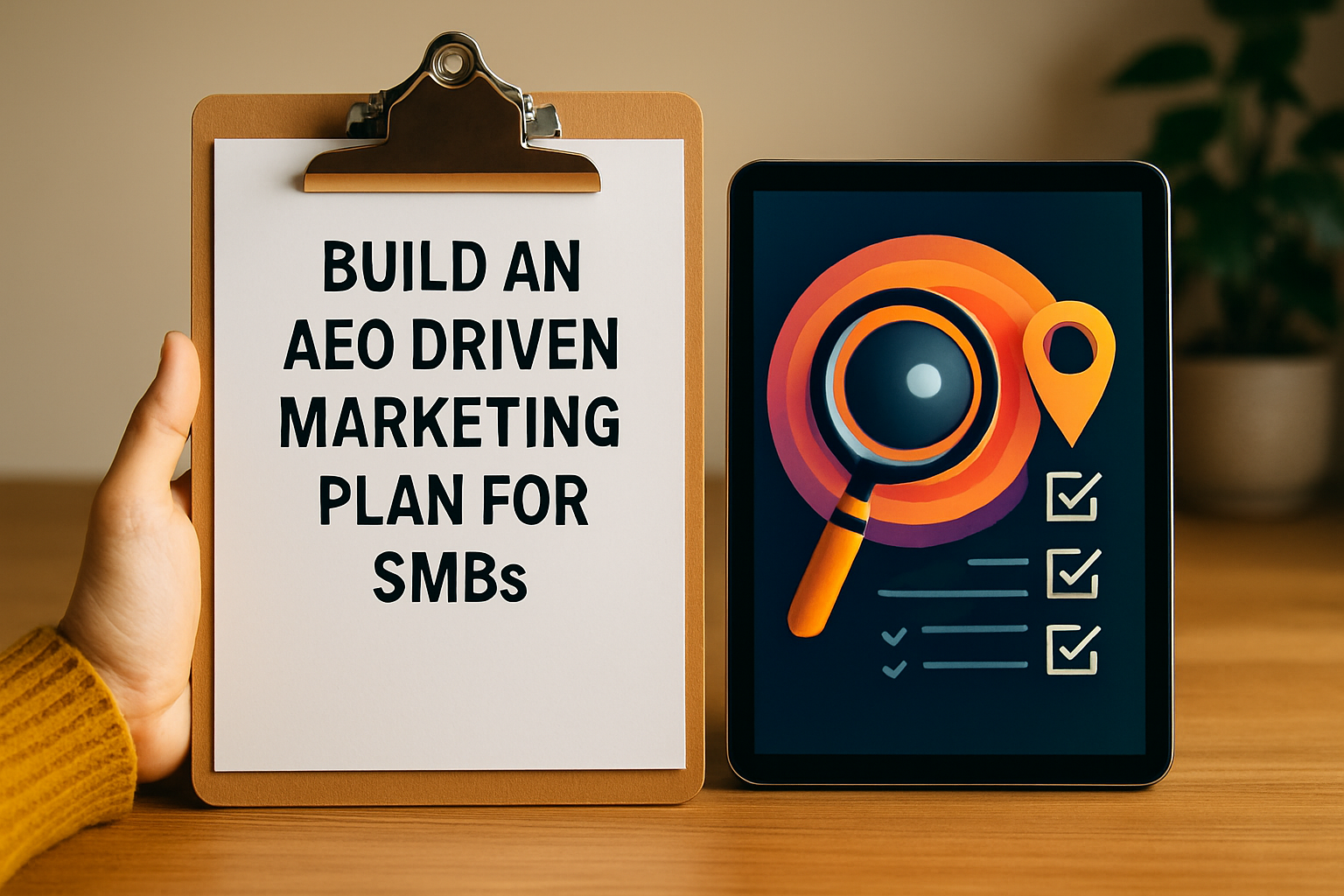How to Automate Lead Generation for Small Businesses

Automated lead generation promises to save businesses hours every week and fill sales pipelines without the daily grind. But surprisingly, businesses using integrated automation platforms see up to 451% more qualified leads, according to Gartner. Most people assume it is all about fancy tools, yet the biggest wins come from actually refining your audience and goals before touching a single piece of software.
Table of Contents
- Step 1: Define Your Target Audience And Goals
- Step 2: Choose Your Lead Generation Tools And Software
- Step 3: Create Compelling Lead Magnets And Content
- Step 4: Set Up Automated Workflows And Campaigns
- Step 5: Test And Optimize Your Lead Generation Process
- Step 6: Monitor Results And Adjust Strategies As Needed
Quick Summary
| Key Point | Explanation |
|---|---|
| 1. Clearly Define Your Audience | Understand who your ideal customers are by analyzing demographics, pain points, and purchasing behaviors. |
| 2. Set SMART Lead Generation Goals | Create specific, measurable, achievable, relevant, and time-bound objectives to guide your lead generation efforts. |
| 3. Choose Integrated Lead Generation Tools | Select software that aligns with your audience and goals, offering multiple functionalities for efficient automation. |
| 4. Develop Compelling Lead Magnets | Create valuable resources that solve target audience challenges, encouraging them to exchange contact information. |
| 5. Continuously Monitor and Optimize | Regularly assess performance metrics and make data-driven adjustments to improve your lead generation strategies. |
Step 1: Define Your Target Audience and Goals
Successful lead generation begins with precise targeting. Before implementing any automation strategy, you must develop a crystal clear understanding of who you want to attract and what specific objectives you aim to achieve. This foundational step determines the effectiveness of your entire lead generation system.
Starting with audience identification requires deep market research and introspection about your ideal customer profile. Analyze your current customer base to recognize common characteristics such as demographic information, professional roles, pain points, and purchasing behaviors. Consider factors like age range, income levels, industry sector, job titles, and specific challenges your product or service solves.
To develop a comprehensive audience profile, gather data through multiple channels. Customer surveys, website analytics, social media insights, and direct client conversations provide invaluable perspectives. HubSpot’s research shows that businesses with well defined target audiences are 2.4 times more likely to experience revenue growth compared to those with generic targeting approaches.
Once you understand your audience, translate this knowledge into specific lead generation goals. These objectives should be SMART: Specific, Measurable, Achievable, Relevant, and Time bound. Instead of vague statements like “get more leads,” create precise targets such as “acquire 50 qualified leads from manufacturing sector within six months” or “increase conversion rate by 25% for small business consulting services by quarter end”.
Your goals must align directly with broader business objectives. For service based businesses, this might mean focusing on lead quality over quantity. A consulting firm, for instance, would prioritize high value leads from decision makers rather than collecting numerous low potential contacts.
To verify you have completed this step effectively, ask yourself these key questions: Can I describe my ideal customer in detail? Do I understand their primary motivations and challenges? Have I established clear, measurable lead generation targets that connect with my overall business strategy? If you can confidently answer yes, you are ready to move forward with designing your automated lead generation system.
Step 2: Choose Your Lead Generation Tools and Software
Selecting the right technology stack is crucial for automating your lead generation process. The tools you choose will serve as the backbone of your strategy, enabling efficient prospecting, nurturing, and conversion tracking. Not all software solutions are created equal, and your selection must align precisely with the audience and goals established in your first step.
Comprehensive lead generation platforms offer integrated solutions that can dramatically simplify your workflow. When evaluating tools, prioritize platforms that provide multiple functionalities such as contact management, email automation, landing page creation, and analytics tracking. According to Gartner’s marketing technology research, businesses using integrated automation platforms see up to 451% increase in qualified leads.
Consider platforms that offer specific features matching your business model. Service based businesses should seek tools with robust CRM integration, automated follow up sequences, and detailed contact segmentation capabilities. Key capabilities to evaluate include lead scoring mechanisms, email template customization, social media integration, and real time performance tracking.
Budget plays a significant role in tool selection. While enterprise grade solutions offer extensive features, many affordable options cater specifically to small businesses. Some platforms provide tiered pricing models allowing you to scale your investment as your lead generation efforts expand. Prioritize tools with transparent pricing and scalable features that can adapt to your growing business needs.
When assessing potential software, request free trials or demo versions. This hands on approach allows you to test user interface, understand integration complexity, and evaluate how well the tool meets your specific requirements. Pay attention to customer support quality, onboarding resources, and community reviews during your evaluation process.
To confirm you have successfully completed this step, create a shortlist of 3-5 potential tools that comprehensively address your lead generation needs. Verify each platform offers core functionalities like contact management, email automation, lead tracking, and reporting. Ensure the selected tools integrate seamlessly with your existing business systems and provide clear pathways for future growth and optimization.
This table summarizes the core features and decision criteria to consider when evaluating lead generation tools for your small business.
| Feature/Criteria | Why It Matters | What to Look For |
|---|---|---|
| Contact Management | Keeps leads organized and accessible | Robust CRM integration, easy segmentation |
| Email Automation | Saves time and personalizes follow-up | Custom templates, drip campaigns |
| Landing Page Creation | Captures lead information efficiently | User-friendly builder, customizable forms |
| Analytics & Reporting | Measures success and guides improvements | Real-time metrics, performance dashboards |
| Integration | Ensures smooth workflow with existing systems | API access, compatibility with your tools |
| Scalability & Pricing | Supports business growth and budget | Tiered plans, transparent pricing |
| Customer Support | Helps resolve technical or onboarding issues | Responsive helpdesk, training materials |
Step 3: Create Compelling Lead Magnets and Content
Lead magnets serve as the critical bridge between attracting potential customers and capturing their contact information. These valuable resources must speak directly to your target audience’s specific challenges and desires, providing immediate tangible value that compels them to exchange their contact details.
Developing high impact lead magnets requires deep understanding of your audience’s pain points. The most effective resources solve a specific problem quickly and comprehensively. For service based businesses, this might mean creating detailed guides, comprehensive checklists, video tutorials, or exclusive research reports that demonstrate your expertise and provide actionable insights. Content Marketing Institute research shows that targeted content can increase lead generation conversion rates by up to 300%.
The format of your lead magnet matters as much as its content. Digital resources like PDF guides, webinars, email courses, and toolkit templates work exceptionally well across various industries. When designing these materials, focus on creating professional, visually appealing content that reflects your brand’s quality and expertise. Use clean design principles, include your brand elements, and ensure the material looks polished and credible.
Content creation should focus on solving genuine problems rather than making sales pitches. Your lead magnet needs to demonstrate immediate value within the first few moments of engagement. For instance, a business consultant might offer a “5 Step Revenue Growth Roadmap” that provides concrete strategies professionals can implement immediately. This approach builds trust and positions you as a knowledgeable resource in your field.
Strategic content distribution amplifies your lead magnet’s reach. Leverage multiple channels including your website, social media platforms, email signatures, and targeted advertising. Create dedicated landing pages with clear value propositions and straightforward opt in processes. Minimize friction by requesting only essential contact information and clearly communicating the benefits users will receive.
To verify successful completion of this step, assess your lead magnet against these criteria: Does it directly address your target audience’s specific challenges? Can a potential lead understand its value within seconds? Have you created a professional, easily consumable resource? Is the opt in process simple and transparent? If you can confidently answer yes to these questions, you have crafted a compelling lead generation asset.
Step 4: Set Up Automated Workflows and Campaigns
Automated workflows transform lead generation from a manual, time consuming process into a streamlined, intelligent system that nurtures potential customers with precision and consistency. These workflows act as your digital sales team, engaging prospects automatically based on specific triggers and behaviors.
Designing effective automation requires strategic segmentation and personalized communication paths. Begin by mapping out distinct customer journeys reflecting different audience segments and their unique interaction points. Your workflow should include multiple touchpoints that gradually build trust and move prospects closer to conversion. According to Salesforce research, businesses using marketing automation see a 14.5% increase in sales productivity.
Start by creating a comprehensive sequence of automated interactions. This typically involves an initial welcome email immediately after lead magnet download, followed by a series of strategic emails that provide additional value. Each email should serve a specific purpose: educating the prospect, addressing potential objections, showcasing social proof, or presenting a soft call to action. The key is maintaining a balance between providing valuable information and gently guiding leads toward your primary offering.
Implement sophisticated triggers that respond to specific lead behaviors. These might include actions like downloading additional resources, clicking specific links, or spending time on particular website pages. Advanced automation platforms allow you to create complex conditional workflows that adapt in real time. For example, a lead who downloads a beginner guide might receive different content compared to someone who accesses an advanced technical resource.
Integrate lead scoring mechanisms within your workflows to prioritize and categorize potential customers. Assign point values to different interactions, allowing your system to automatically identify high potential prospects.
This approach enables more targeted follow up and helps sales teams focus their efforts on the most promising leads.
To verify successful workflow implementation, assess your automation against these criteria: Does each workflow have a clear objective? Are communication sequences logically structured? Have you created personalized paths for different audience segments? Can leads move seamlessly through different stages of engagement? If you can confidently answer yes, you have established a robust automated lead generation system that works continuously to attract and nurture potential customers.

Step 5: Test and Optimize Your Lead Generation Process
Continuous improvement is the cornerstone of successful automated lead generation. Testing and optimization transform your initial strategy from a static system into a dynamic, responsive mechanism that consistently adapts to changing market conditions and audience behaviors.
A/B testing provides the most powerful method for systematic performance improvement. This approach involves creating multiple versions of your lead generation elements and comparing their performance. Test different variables such as email subject lines, landing page designs, call to action placements, and content messaging. Small modifications can yield significant improvements in conversion rates. MarketingExperiments research indicates that strategic A/B testing can increase conversion rates by up to 49%.
Establish a comprehensive tracking system that monitors key performance indicators across your entire lead generation funnel. Critical metrics to track include lead capture rate, email open rates, click through rates, conversion percentages, and overall customer acquisition cost. Use advanced analytics tools that provide granular insights into how prospects interact with your automated workflows, identifying potential bottlenecks or drop off points in the customer journey.
Implement a regular optimization schedule to ensure continuous refinement. Set aside dedicated time monthly or quarterly to review your lead generation performance. During these review sessions, analyze collected data, identify underperforming elements, and develop hypotheses for improvement. Be prepared to make incremental changes rather than complete overhauls, allowing you to understand the direct impact of each modification.
Consider implementing more advanced optimization techniques like multivariate testing, which examines multiple variables simultaneously. This approach provides deeper insights into how different elements interact and influence overall performance. Pay special attention to audience segmentation, ensuring that your optimization efforts consider the nuanced preferences of different customer groups.
To verify successful optimization, assess your process against these criteria: Have you established a consistent testing framework? Are you tracking comprehensive performance metrics? Can you demonstrate measurable improvements in lead generation efficiency? Do you have a clear process for implementing and evaluating changes? If you can confidently answer yes to these questions, you have developed a robust, adaptive lead generation system that will continue to evolve and improve over time.
Step 6: Monitor Results and Adjust Strategies as Needed
Successful lead generation is not a set it and forget it process but a dynamic, continuous journey of refinement and strategic adaptation. Monitoring your results provides critical insights that enable informed decision making and sustainable business growth. Your ability to interpret data and make timely adjustments will determine the long term effectiveness of your automated lead generation system.
Develop a comprehensive dashboard that consolidates key performance indicators from multiple sources. This centralized view should integrate data from your CRM, email marketing platforms, website analytics, and lead generation tools. According to Forbes research, companies that leverage data driven marketing are six times more likely to be profitable year over year.
Establish a regular reporting rhythm that allows for both tactical and strategic reviews. Weekly tactical reviews should focus on immediate performance metrics such as lead volume, conversion rates, and engagement levels. Monthly strategic reviews provide opportunities for deeper analysis, examining broader trends, identifying emerging patterns, and making significant strategic adjustments. During these reviews, compare current performance against initial goals and assess the overall health of your lead generation ecosystem.
Pay close attention to qualitative indicators alongside quantitative metrics. While numerical data provides essential insights, understanding the subjective experience of your leads is equally important. Track metrics like lead quality, sales team feedback, and customer satisfaction scores. These softer indicators often reveal nuanced insights that pure numerical data might miss. Consider implementing periodic surveys or feedback mechanisms to gather direct input from potential and converted customers.
Be prepared to make both incremental and substantial strategy adjustments based on your findings. Some changes might involve refining email subject lines or tweaking landing page designs, while others could require more significant shifts in targeting, messaging, or even the fundamental approach to lead generation. Maintain flexibility and view each adjustment as an opportunity for learning and improvement.
To verify successful monitoring and adjustment, assess your process against these criteria: Have you established a consistent review schedule? Can you demonstrate data driven decision making? Are you tracking both quantitative and qualitative metrics? Do you have a clear process for implementing strategic changes? If you can confidently answer yes to these questions, you have created a responsive, intelligent lead generation system capable of continuous improvement.
Here is a checklist table to help you verify if you have successfully completed each key step in automating lead generation for your small business.
| Step | Completion Criteria | Verified (Yes/No) |
|---|---|---|
| Define Audience & Goals | Can you describe your ideal customer and have clear, measurable goals aligned with your business strategy? | |
| Choose Tools & Software | Have you shortlisted 3-5 tools with needed features and ensured seamless integration with your current systems? | |
| Create Lead Magnets & Content | Does your lead magnet address audience challenges, look professional, and offer clear value with a simple opt-in? | |
| Set Up Automated Workflows | Do your workflows have clear objectives, logical communication sequences, and personalized paths for different segments? | |
| Test & Optimize | Is there a consistent framework for A/B testing, metric tracking, and demonstrating measurable improvements? | |
| Monitor & Adjust | Have you established regular review schedules and data-driven processes to make both small and strategic adjustments? |

Ready to Turn Automated Lead Generation Into Real Small Business Growth?
Feeling stuck running manual lead generation and juggling endless tools? You read in this article how small businesses face lost time, scattered efforts, and missed leads without a tightly automated system. If you want to achieve those SMART lead goals, streamline contact management, and close more opportunities faster, the right solution must address every pain point discussed—from automated nurturing to real-time engagement.

Upgrade now and see real results. Authority Echo gives you an all-in-one platform that builds on every step in this guide—integrating AI prospecting, personalized workflows, and calendar management to automate lead capture and follow-up. No more switching between apps or losing leads in the shuffle. Make your next move count. Visit your Authority Echo dashboard and start your free trial today. Experience measurable results in lead conversion, payment processing, and client loyalty—get ahead while your competitors are still piecing things together.
Frequently Asked Questions
How can I define my target audience for automated lead generation?
To define your target audience, analyze your current customer base to identify common traits such as demographics, job roles, and pain points. Conduct surveys and utilize website analytics to gather insights, helping you create a detailed ideal customer profile.
What tools should I consider for automating lead generation?
Choose lead generation tools that offer functionalities like contact management, email automation, and analytics tracking. Aim to select 3-5 platforms that align with your specific business needs and ensure they can integrate seamlessly with your existing systems.
How do I create effective lead magnets for my small business?
Develop lead magnets by addressing specific challenges your target audience faces. Create valuable resources, such as guides or checklists, that provide immediate benefits, making sure the content looks professional and engaging.
What steps should I follow to set up automated workflows?
Map out customer journeys based on audience segments and design workflows that include various touchpoints, such as welcome emails and follow-up sequences. Ensure each workflow has a clear objective and adapt paths based on lead behaviors to nurture prospects efficiently.
How can I test and optimize my automated lead generation process?
Implement A/B testing by comparing different versions of your lead generation elements, such as email subject lines and landing pages. Regularly track the performance of your campaigns, making data-driven adjustments to enhance conversion rates and overall effectiveness.
How often should I review my lead generation metrics?
Establish a routine to review your lead generation metrics, conducting weekly tactical assessments and monthly strategic evaluations. This will help you identify trends, make informed adjustments, and sustain improvements over time.




